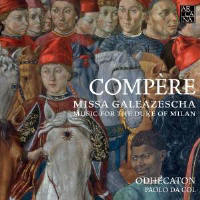Texte paru dans: / Appeared in: |
|
|
Outil de traduction ~ (Très approximatif) |
|
|
Reviewer: J.
F. Weber Subtitled “Music for the Duke of Milan,” this program features the first recording of a work by Loyset Compère (c. 1445–1518), an exact contemporary of the more celebrated Josquin des Prez, Pierre de la Rue, and Heinrich Isaac. Compère and Weerbecke were the principal composers at Galeazzo’s court. The title work is not a Mass at all, but a group of motets that fits into the structure of the Mass (introit, Gloria, Credo, offertory, Sanctus, elevation, Agnus, Deo gratias). It is named after the tyrant Duke Galeazzo, who ruled from 1466 until his murder in 1476, and it is not even clear that the composer assigned the title to this music. Found in one of three great music manuscripts compiled at the cathedral, the work belongs to the category of motetti missales that were used in Milan at the time (one such work has been attributed to Josquin in the mistaken belief that he served there at the time). The music fits the celebration of a Mass in honor of the Blessed Virgin, even at the elevation, which makes only a brief bow to the mystery of Redemption. Three instrumental works by Heinrich Lübeck are performed by the Ensemble Pian&Forte. Johannes Martini has an instrumental piece by La Pifaresca and an organ work played on the 15th-century organ of San Petronio Basilica. Gaspar van Weerbecke is represented by three motets and an organ piece. Alexander Agricola is accounted for by two vocal works, an instrumental work, and an organ piece, and Compère also has an organ piece. The notes call this a “patchwork” of music for the duke, and so it is. Not only are composers, performers, and musical forms alternated regularly, but even the Mass-motets are separated by other selections, mostly instrumental.
Arcana has
been catching up to a backlog of unreleased projects; this was made in 2005.
Under its patchwork appearance is a fascinating glimpse at the Sforza era of
Milan and his lavish endowment of musical resources for his court and
chapel. This disc has no competitor, and specialists will want to hear it.
| |
|
Support us financially by purchasing this disc from eiher one of these suppliers. Un achat via l'un ou l'autre des fournisseurs proposés contribue à défrayer les coûts d'exploitation de ce site. |
|
|
|
|
|
Cliquez l'un ou l'autre
bouton pour découvrir bien d'autres critiques de CD |
|




